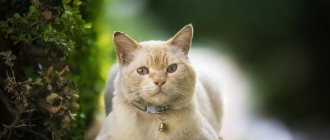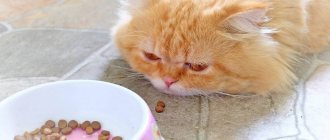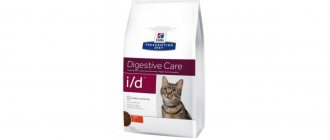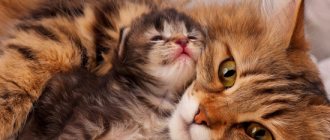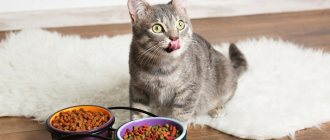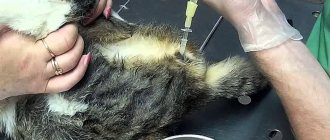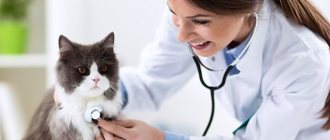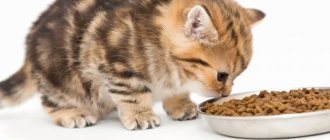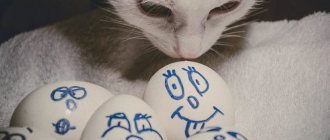Regardless of how thin or obese the cat is, this will in any case negatively affect its health. Regardless of the condition, the animal develops a phalanx of certain pathologies. If you are faced with the fact that your cat has lost a lot of weight, we will tell you what to do in this case.
Is fattening required?
How can you tell if a cat is thin, has a normal weight, or is “fat”? First of all, there are a number of important points to note:
- The owner should not compare it with the pets of friends, neighbors, or close relatives. After all, in this matter there is individuality. Even 2 kittens from the same litter can have different constitutions: 1 is excessively thin, and the second is well-fed.
- If we are talking about purebred pets, then there are certain standards. Typically, the table indicates both minimum and maximum data - height and body weight.
- If the cat is of “noble” origin, then you will have to navigate “by eye,” or rather, by touch. The animal should be placed in a standing position - the front legs are straight, the hind legs are slightly pulled back, in the direction of the tail. You need to feel his spine, it should be smooth. While stroking your pet, the outer ribs should not be felt, and this is considered normal. Then the pelvic part is palpated - a moderately well-fed animal has a smooth croup, with slightly protruding knuckles. The abdomen may be taut or slightly saggy. When moving, a fold forms in the peritoneum area - this is also normal. There is a thin layer of fat on the sternum and abdomen that can be felt.
As a rule, even skinny representatives of the species develop a small layer of fat in the cold season.
External signs of thinness. A pet can be called thin if it has:
- the spinal column and ribs are visible upon visual inspection;
- the hip joints clearly protrude into tubercles;
- a depression is noticeable in the area of the peritoneum;
- the muscles of the forearms, hind limbs, and sternum “fall off.”
The constitution and muscle tone of the animal are always taken into account. Many of the cats appear thin in appearance, but at the same time they have developed muscles.
We make a calculation.
It is impossible to calculate the “ideal” weight of a pet using mathematical calculations of coefficients or a formula.
For example, the standard weight of “British women” varies from 4.2 to 6.8 kg. However, there is a recorded case where a male of this breed reached a weight of just under 14 kg. At the same time, he was physically healthy, although the giant was still excluded from breeding (read in the article how much a cat should weigh depending on breed and age).
Anorexia
The disease can be called an extreme degree of exhaustion only conditionally.
Anorexia is characterized by severe thinness due to a dulled feeling of hunger. And if in humans the reasons are obvious, then in cats everything is not so simple. Let's list some of them:
- Chemotherapy course. Treatment of malignant tumors is often accompanied by a host of side effects. One of them is a radical refusal to eat. The cat loses interest in food, refuses to play, prefers to hide in secluded places and sleeps a lot.
- Consequences of a major operation . Medicines, including anesthesia, greatly affect the pet’s mood and its orientation in space. They can have a detrimental effect not only on taste preferences, but also completely deprive them of interest in food. Even months later, your cat may still feel the effects of a major surgery.
- Failure of the senses. Usually associated with traumatic brain injuries. This leads to disturbances in neural communication, loss of taste or smell. The cat simply does not understand what is edible and what is not. She can experiment, but in most cases she will get a negative experience. All this leads to the described illness.
Anorexia is very different from simple weight loss. In this case, simple fattening is not enough.
In any case, you should contact a veterinarian, get tested and undergo a course of treatment.
The dangers of excessive fattening
For those owners who want to fatten their pet for their own aesthetic needs - to admire how funny the cat licks or runs - it is useful to learn about the consequences of feline obesity. Since obesity in cats, like in humans, is a disease, a fat cat will sooner or later face health problems, including:
- Diabetes of the second type - being initially not prone to diabetes, your pet can develop it with an incorrect lifestyle and, in particular, nutrition. As a result, the owner will have to periodically inject insulin into the cat in order to avoid a sharp deterioration in his health;
Diabetes is one of the most dangerous consequences of overfeeding a cat.
Gaining excess weight is fraught with heart attacks leading to heart attack
Overweight cats have a more difficult time recovering from fractures due to the heavy load on the joints.
In advanced cases, arthritis can only be treated with a surgical scalpel
What to feed to gain weight?
There are feeds for increasing the weight of animals, called medicinal, but they are more expensive than usual. However, if the pet is in critical condition and does not digest natural food well, this is the only feeding option.
If the weight loss is insignificant, you can fatten your pet with natural products. Weight gain is achieved by intelligently replacing proteins with carbohydrates. It is better to avoid fatty foods (or reduce them to a minimum); strive to gain muscle mass, not fat.
From hand
What can you feed your cat to make him fat?
- Meat : rabbit, chicken should be in the diet daily (60-75% of the total diet). To eliminate the risk of infection with worms, the meat must be deep frozen (sometimes it can be boiled) before consumption.
- Fish : ocean only. Make sure that there are no bones in the fish, as they contribute to the development of diseases of the urinary organs.
- Eggs (white and yolk): boiled and raw. Use no more than 2 times a week, 1 pc.
- Dairy products : cottage cheese, sour cream, unsweetened yogurt. It can be introduced into the diet gradually; it is better not to use store-bought products.
- Milk should be completely excluded from the diet of a domestic cat, as it puts a lot of stress on the liver and is poorly digested.
- Hard cheese . Useful in small doses; if overused, it can overload the liver.
- Cereals : rice, buckwheat, millet, etc. 1 teaspoon for each meal.
- Fruits . If the cat doesn’t mind, then you can, but you shouldn’t force feed it.
- Greens : parsley, dill, lettuce. Greens help improve digestion, so it is useful to add them to every meal.
- Oils : sunflower, flaxseed, olive. Only as a supplement.
Your task is to formulate your cat’s daily routine so that the body has to spend as little energy as possible. Reaching the golden mean is difficult, especially if the pet is overly active and picky about food.
Attention! Avoid sausages, canned meat and fish; such products contain a lot of salt and spices. They can harm the cat's digestive system.
Nutrition needs to be reviewed
To speed up the weight gain process, use vitamin supplements. They activate metabolism, which will force the body to digest and absorb food faster. It is important to consult your veterinarian before using vitamins.
Feeding rules
You need to feed a kitten to gain weight taking into account general recommendations and rules. Among the foods that will contribute to moderate obesity in your pet, it is worth highlighting the following:
- lean meat. This product should make up the lion's share of the diet;
- carbohydrates. It is recommended to feed your cat cereals. Nevertheless, it is better to immediately remove rice and pearl barley from the daily menu; sea fish. Give preference to low-fat varieties;
- dairy products. In order to stimulate digestive processes, you should definitely worry about feeding your cat kefir, cottage cheese, and sour cream.
If you want to fatten up your cat as quickly as possible, but do not want to bother with creating a menu of homemade products and constantly purchasing them, there is an alternative option - industrial food. If you buy a premium composition, you will provide your pet not only with ingredients that are important for him, but also with various vitamin supplements. Such mixtures are distinguished by a balanced composition, which will solve all nutrition problems.
Interestingly, some modern manufacturers produce cat food specifically for malnourished animals. They contain large quantities of mineral supplements and vitamin complexes that quickly normalize your pet’s health. As a result, he will begin to gain weight actively.
How to identify excessive thinness in a pet
Due to the large number of breeds, many cats have significant differences in appearance. This is why some people may mistake a slender and lean animal for an emaciated one. You need to know the difference between physiological and pathological thinness.
Signs of a healthy cat with a slender physique:
- the proportions between the sizes of the head, torso and limbs are observed;
- ribs and vertebrae are not visible through the layer of wool, but are easily found when palpated;
- the waist is pronounced;
- there is a thin layer of fat in the chest and abdomen area;
- the animal is active, plays a lot and eats with appetite;
- The coat is smooth, shiny, easy to comb and does not fall out.
Oriental breed cats have well-developed muscle mass and a small layer of fat
With pathological thinness, the following signs are observed:
- protruding shoulder blades, ribs, hip bones are visible to the naked eye;
- the head and ears are sharply enlarged compared to the body, the limbs are thin;
- the muscles are poorly developed, fatty tissue on the abdomen and back cannot be felt;
- the fur falls out in uneven tufts, there may be tangles;
- the animal spends a lot of time sleeping, moves little, and changes in appetite are observed (ravenous hunger or complete lack of desire to eat).
When a cat is emaciated, bones can be seen through the skin.
When a cat needs feeding
Before you start fattening a cat, you need to understand the reasons that prompted the owner to make such a decision. If cats are not sick or hungry, they are able to independently control their weight and the amount of food they consume.
Not all cats need an increase in diet
Among the good reasons why a cat owner can begin to purposefully feed him are the following:
- Gaining normal weight after a debilitating illness. The most common cause of weight loss in cats is all kinds of parasites that literally suck all the vitality out of the cat. Other pathologies that negatively affect an animal’s weight include gastritis, ulcers, and other digestive disorders. Such an innocent thing as dysbiosis in its neglected form leads to frequent vomiting, and – as a result – rapid weight loss. All of these conditions are abnormal for a cat and require a balanced diet for weight gain;
Recovery from illness takes a lot of resources from the body and takes time.
At home, previously homeless cats do not immediately get used to the abundance of food.
Exhibition animals are subject to strict weight requirements.
Many cats lose their appetite when faced with intense negative experiences.
Aging cats are more sensitive to low-quality or too strong food
Recipe No. 2
Fresh meat for lunch:
- Chicken breast - 100 g.
- Lean pork meat (can be replaced) - 30 g.
- Rice - 1 tbsp. spoon.
- Chopped parsley - a handful.
- Vegetable oil - 1 teaspoon.
Chop the meat with a knife and mix with the rest of the ingredients. Store for no more than 2 days.
Fresh meat for lunch
What age can be considered correct to buy a kitten?
A small one-month or two-month-old kitten looks funny and very cute. Those who want to get a furry friend think that a kitten at three or four months is already too big, will not be able to quickly get used to a new place, and will play less. The buyer, fascinated by the cute face, does not think about the fact that he will have to replace the kitten’s mother and teach him to eat, use a tray and scratching post, wean him from gnawing wires, biting, scratching and many other important things
And it doesn’t matter whether he’s purebred..
Discussion
Everything is correct) We have reserved our kitty, we will pick it up at 4 months) In the meantime, she hangs out with her sisters, mommy, learns good manners, she gets her first vaccinations and sends us reports and photos)
Our cat came to us at 4.5 months. I managed to see enough of the childish expression and funny behavior. Got used to it instantly.
Why does my cat need to lose weight?
A single kilogram of excess weight already increases the risk of your pet developing serious diseases. Unfortunately, if your cat is overweight or obese, it is no longer a question of whether she will develop complications and illnesses associated with it, but when exactly they will appear and how serious they will be. Most often, excess weight is accompanied by:
- Type II diabetes – it is three times more common in obese cats than in animals of normal weight;
- Heart diseases;
- Increased risk of joint injuries;
- Osteoarthrosis (arthritis);
- High pressure;
- Some forms of cancer, especially tumors in the abdominal cavity.
Overweight and obese animals tend to live shorter lives than their slender counterparts. If a cat is overweight, it moves less and becomes less energetic and playful. The purr prefers to just lie down, and because of this it is easy to miss the first signs of illness, mistaking lethargy for “normal laziness.”
Now we are just beginning to understand the danger that extra pounds can pose to both humans and their four-legged friends.
Scottish and British breeds
These seals, by their constitution, are designed in such a way that they should be relatively massive. When deciding how to fatten a Scots cat, you need to focus on the norm. You want him to be at his ideal weight and not overeat? Then you should understand that a healthy animal without pathologies cannot be heavier than five to six kilograms.
For a Scot this is a perfectly acceptable option. If he weighs more, he may become obese. When a caring owner is thinking about how to fatten a British cat, you need to understand the natural characteristics of the breed. These animals look quite massive due to their dense short hair. The ideal weight of a Briton ranges from six to nine kilograms. It is undesirable to gain large amounts of weight, since in this case there will be a serious load on the cardiovascular system.
Recipe No. 5
Milk breakfast:
- Powdered milk - 1 tbsp. spoon.
- Chicken eggs - 2 pcs.
- Cottage cheese - 3 tbsp. spoons.
- Chopped vegetables - 2 tbsp. spoons.
Add a few tablespoons of cold water to the milk powder, then beat in the eggs and bring the mixture until smooth. Gradually stir in cottage cheese and vegetables. Pour the mixture into the pan and cook for 2 minutes on each side. Cool, cut and serve to your pet.
Milk breakfast
Attention! Remember, no salt or spices should be used in any recipe. They will irritate the animal’s receptors, which will negatively affect its sense of smell and perception of taste.
Dry food for weight gain
Today, many owners switch their pets to ready-made diets, or the animal ends up in a home with already established taste habits. What food is suitable for your pet to gain weight to normal? According to clinical studies:
- The product must be premium or super-premium and not contain chemical additives.
- It is desirable that the composition contains vitamins and coarse plant fibers that are beneficial for digestion processes.
- Many manufacturers produce lines of special diets designed for pets that are gaining weight. It is worth paying attention to similar products labeled Gastro Intensinal.
- Must consist of high-quality ingredients - meat, grains, offal, and in composition be as close as possible to the animal’s usual complete diet. Ready-made food is valued not only for the composition of its components, but also for their proper combination and ratio.
- It is important to adhere to the recommended dose; it is usually indicated on the back of the package. For more accurate dosage, it is better to use a measuring cup or spoon. Often the owner thinks that his pet eats too few granules and does not finish eating. However, it is worth considering that the satiety of the diet is sometimes not related to the serving size. Typically, the consumption of a high-quality product is much lower than that of cheap, low-quality diets.
When “fattening” your pet, you should not significantly increase the portion of food. This is more likely to lead to problems with digestive processes than to restoring body weight.
Sources of fats
This element must be included in a cat’s natural diet, since it is not only, along with carbohydrates, a source of energy, but also supplies the body with many vitamins:
- A - improves vision, is responsible for the condition of the skin and coat;
- D - is of great importance for the formation of the skeleton;
- E - strengthens muscles, regulates the normal functioning of the genitourinary system;
- K - is an important element for strengthening joints and bones, and the functioning of the cardiovascular system.
In addition, fats give food an attractive taste and smell, promote intensive growth and harmonious development of the animal. Their share in the pet’s diet with natural nutrition should be at least 20%.
If it is not possible to provide the animal with food with a sufficient amount of these components, then fish oil can be added to it.
Choosing a kitten in 10 steps. Blog of user Mira88 on 7ya.ru
So, you have decided to get serious about buying a purebred kitten and want to know how this should happen.
Below I will give a few key points that must be taken into account so that the purchase does not cause disappointment. Choose and buy a kitten personally. The kitten should be chosen by the future owner himself, or by the owners if the family consists of several people. Remember that you choose not only a kitten, but also a breeder with whom you will have to communicate after the purchase for advice. Before... Discussion
Today there is still a lot of pain that animals endure, so to speak, and you know in such a situation it is still quite important to choose the same kitten with a full package of documents. Yes, I agree with you that this way you will have to spend more money than even buying a kitten from the market, but at the same time you will be sure that the cat is healthy
In addition, when I adopted the kitten three months ago, even though I had documents, I took the kitten for examination to a doctor.
Mistakes and dangers
A common belief is that cats will not eat anything that can harm them. In fact, this is not so; pets often eat food that is not healthy and even harmful to them. Most often this happens because their owners make the following mistakes:
- They feed from the table. Pets often ask to share human food, and not all owners can resist. Remember, your food contains a large amount of salt and spices, which are harmful to the digestion of animals.
- Mix types of food. Decide on your pet’s type of food: natural or industrial food. Both methods have their advantages and disadvantages, but combining them leads to indigestion.
- They ignore daily norms. It is easy to feed a cat to be fat, since this simply requires giving him an unlimited amount of food every day. If you do not pursue such a goal, it is better to stick to the daily intake (discuss with your veterinarian).
- They switch abruptly from one type of food to another (from natural to dry food). The change in feeding method must be smooth, otherwise the pet will develop vomiting or diarrhea.
Visit to the veterinarian
From this video you will learn how to feed your cat correctly so that he grows up healthy.
Consultation with a specialist is necessary in order to exclude the presence of serious diseases. If you don't do this, sooner or later you will begin to doubt the correctness of your chosen tactics. When thinking about how to fatten a skinny cat, you need to act consistently. The veterinarian will examine the animal and do the necessary tests.
The overall picture will become clear when you conduct a full examination of your pet. If no diseases are detected, then you need to pay close attention to nutrition. A lot depends on food: energy level, activity, presence or absence of appetite. Any knowledgeable specialist will tell you that proper nutrition is the basis of health.
What feed is best to use?
If the cat is very thin and emaciated, then a veterinarian will help you choose the right diet. Most often, experts recommend using ready-made dietary products that are sold in pet pharmacies.
The most popular brands are:
- Hill's a/d;
- Royal Canin Recovery;
Royal Canin Recovery food is well suited for cats that are weak or sick, it is easily digestible and gives the animal a lot of energy.
- ProPlan Convalescence.
All these diet foods are produced in the form of soft food - pates. This form was not chosen by chance. Soft food is easier to digest, and this is what a depleted body needs. The gastrointestinal tract will not be overloaded and the cat will not spend extra energy on digestion. If the cat is exhausted to such an extent that she can no longer eat on her own, then this kind of nutrition can be easily administered through a tube.
The food is distinguished by a high content of elements such as fat and proteins, vitamins and minerals. Thanks to this composition, the body recovers faster.
Wet food is also used for emaciated kittens. This diet is high in calories and also contains more vitamins necessary not only for recovery, but also for growth.
It is better not to use dry food during this period. They belong to tough and solid foods. Depending on the reasons for weight loss, not every cat will be able to easily digest such food.
Breed characteristics
Animals with malnutrition do not have enough nutrients in the body, they have an acute lack of vitamins, and poor functioning of the digestive system. Consequently, the diet of such animals will differ in some features:
- High calorie content. This is due to the fact that a fat layer can only form if the incoming calories are not completely consumed during the life of the animal. For a cat, the main source of energy is fats, carbohydrates are secondary.
- High protein content, and high quality. Fasting causes amino acid deficiency. You can only replenish it by consuming whole sources of protein, such as meat. Proteins of plant origin should not be used in a cat’s diet, as they do not provide any value to the animal.
- Easy to digest. A weakened cat may simply not have enough energy to absorb and digest food normally, so the components of the diet must first be broken down into simpler components. Such food will require minimal energy expenditure to digest it.
In order for the animal to gain weight faster, feeding must be carried out on a schedule. The portion size should be small and the number of approaches should be frequent. You cannot mix industrial feed and natural food, this will cause digestive upset and the digestibility of food will decrease.
As for kittens, to fatten the animal it is necessary to resort to the same method as with an adult cat: small portions and frequent meals. However, the food itself should be somewhat different. Of course, it is better to resort to ready-made food that is balanced in the composition of vitamins and microelements. But if the owner subsequently plans to feed the pet natural food, then you can use meat baby food with vegetables.
It turns out that this matters too. When wondering how to fatten a cat, you need to pay attention to the breed characteristics. You need to understand that a Siamese cat, by definition, cannot be fat. If the owners are too zealous in feeding, the animal is more likely to acquire a lot of health problems than to get better.
We suggest you read: Description of the Russian Blue cat breed
If you are thinking about how to fatten a Bengal cat, you need to take into account that the breed’s peculiarity requires them to remain at a weight of three to four kilograms. There is no need to try to break the norm on your own. Otherwise, the animal will become obese. It is necessary to clearly differentiate where weight gain is required, and in which case it is worth abandoning the idea itself.
How long does it take to train a cat to go on a diet?
Give your cat a week or two to get used to the new diet. First, mix ¼ of the new food with ¾ of the usual food for 2 to 4 days. Then increase the amount of new food to half, and in the last 3 to 5 days before the final transition to the new diet - to ¾.
To improve palatability, you can heat the food and add flavoring additives, for example, based on fish oil containing Omega-3 fatty acids.
If your cat refuses a new diet, or if you have any questions while introducing her to a new food, do not hesitate to contact your veterinarian for advice.
How not to harm your health
If a cat becomes big and fat, he begins to have serious health problems. Kidney stones, heart disease - all this is a consequence of obesity. You will need to limit your pet's access to food somewhat, as he may become fat too quickly. You should not immediately fatten your pet with large portions of food. They must be increased gradually - then the stomach of the four-legged creature will stretch, and it will begin to eat more.
In this case, experts recommend that cat owners purchase various vitamin supplements from veterinary pharmacies or pet stores. Their regular use by your cat will increase his appetite.
Another key point: try to warm it up before serving food to your animal. In this case, the foods that the fluffy eats will be absorbed much better.
Remember why there is a need to fatten your pet, and do it wisely, taking into account general recommendations.
Table: comparative characteristics of dietary feeds of various brands
| Name of food | Class | View | Flavors | Peculiarities | Price |
| Eukanuba Adult Sterilized Weight Control Chicken | Superpremium | Dry | Chicken | Designed for sterilized and neutered male cats |
|
| Hill's Prescription Diet Metabolic Weight Management | Superpremium | Dry | Chicken | Allows you to maintain optimal weight |
|
| Hill's Prescription Diet Metabolic + Urinary Weight Care | Superpremium | Dry | Chicken, turkey | Also used for cats with urinary tract diseases |
|
| Hill's Prescription Diet i/d Digestive Care (jelly) | Superpremium | Wet | Chicken | Helps maintain a healthy digestive tract |
|
| Hill's Prescription Diet w/d Digestive/Weight Management | Superpremium | Dry | Chicken | Helps normalize weight in diabetic cats |
|
| Hill's Prescription Diet w/d Digestive/Weight Management (jelly) | Superpremium | Wet | Chicken | Better absorbed by the pet's stomach |
|
| Royal Canin Satiety Weight Management SAT34 | Superpremium | Dry | Chicken, poultry | Can be used for diabetes and urolithiasis |
|
| Royal Canin Neutered Adult Maintenance | Superpremium | Wet | Chicken, pork, poultry, liver | Suitable for sterilized animals in the postoperative period |
|
| Pro Plan Veterinary Diets Feline OM Obesity (Overweight) Management dry | Premium | Dry | Chicken, poultry | Used for adult cats |
|
| Farmina Vet Life Natural Diet Cat Obesity | Premium | Dry | Chicken, pork, poultry | Prevents muscle loss | 2 kg - 1709 rub. |
| Royal Canin Satiety Weight Management (jelly) | Superpremium | Wet | Chicken | Suitable for pets with diabetes |
|
| Purina Pro Plan Veterinary Diets OM pouches | Superpremium | Wet | Chicken | Helps maintain weight |
|
| Happy Cat Adipositas | Superpremium | Dry | Chicken, poultry | Also used for cats with liver disease |
|
| Brit VDC Obesity | Superpremium | Dry | Chicken | Suitable for British cats, grain free | 2 kg - 1240 rub. |
| Forza10 Active Line | Superpremium | Dry | Fish | Consists of heart-shaped granules | 454 g - 470 rub. |
| Enova Breeder Cat Light Indoor | Superpremium | Dry | Chicken, rice | Can be used to feed cats over 7 years of age | 10 kg - 6300 rub. |
| Bosch Sanabelle Light for cats prone to obesity | Superpremium | Dry | Bird | Provides quick satiety due to the large amount of dietary fiber | 2 kg - 1300 rub. |
| Barking Heads Adult Fat Cat Slim | Holistic | Dry | Chicken, salmon | Suitable for pets with sensitive stomachs |
|
| 1st Choice Weight Control | Superpremium | Dry | Chicken | Designed for adult animals | 5.5 kg - 2600 rub. |
Photo gallery: examples of dietary foods
Hill's Prescription Diet i/d Digestive Care stimulates the stomach and intestines Purina Pro Plan Veterinary Diets OM pouches improves digestion Royal Canin Satiety Weight Management comes in jelly form Forza10 Active Line has an original heart-shaped granule shape Happy Cat Adipositas helps reduce weight in cats with disease liver Hill's Prescription Diet w/d Digestive/Weight Management is used for cats with diabetes Hill's Prescription Diet Metabolic Weight Management helps maintain proper body weight Pro Plan Veterinary Diets Feline OM Obesity allows you to quickly lose excess weight
Feeding cats when exhausted: food, diet, special food
Unfortunately, domestic cats often end up on the street after being abandoned by their owners. In addition to the fact that during this period the animal experiences incredible stress, it has to learn to survive in a new, completely unfriendly environment, getting its own food. In most cases, abandoned cats turn out to be unadapted to life in such conditions; they fall into a state of depression and starve.
Often cats abandoned by their owners are found in a state of extreme exhaustion and immediately tried to fatten. First of all, you need to follow a special diet, do not load your stomach, take food off your stomach and provide rest. As a rule, an exhausted body reacts with a decrease in temperature, which can be critical. The cat needs to be warmed up.
But exhaustion can occur not only in abandoned cats, it can also affect domestic cats. It is important to notice in time your pet’s loss of interest in food and weakness.
Signs of exhaustion
First you need to figure out what exhaustion (cachexia) is. If a cat suddenly loses weight during the mating season, this is not cachexia and does not require treatment. Also, cats may become thinner in the hot season or due to stress, but they will soon return to their normal weight.
Domestic cats suffering from malnutrition and anorexia are quite rare. However, cachexia can develop due to long-term loss of appetite, for example, when changing food or severe stress. Sometimes a cat's body can be exhausted by childbirth or surgery.
If the cat is lethargic, its figure resembles an hourglass, its stomach is sunken, and there is no layer of fat on the ribs - these are clear signs of exhaustion. A loss of more than 10% of body weight is considered critical.
Basic rules for feeding a cat during exhaustion
An exhausted cat needs nutritional therapy. You need to feed her exclusively in small portions (no more than 20 g per meal), every 3 hours. The serving size depends on the condition of the pet. Food should be easily absorbed by the body and have high energy value.
Important: an emaciated cat is fed in very small portions of 15–20 g every 3–4 hours.
Products for feeding need to be crushed. A cat in a state of exhaustion does not have enough strength to chew large and tough pieces of food. For this reason, she may refuse to eat.
For kittens, food is ground in a blender; for adult pets, it is enough to chop it very finely.
Natural products for cat exhaustion
The products from our table are not suitable for dietary therapy of cats with cachexia (moreover, such food is not suitable even for healthy animals). Our food may contain sugar, salt, spices, smoked meats, and dyes that are contraindicated for cats.
The cat must drink water. If she refuses to drink for more than a day, it is necessary to carefully pour in some water with a teaspoon. This must be done very carefully, no more than two teaspoons at a time, every hour (until the cat starts drinking on its own).
In the first days of the diet, it is best to give your cat a light broth of white chicken meat and a little chopped boiled chicken breast. At night you can give about 2 tbsp. l. low-fat kefir. It is better not to feed raw meat yet; it takes much longer to digest.
On the third day of the diet, you need to start introducing other foods. Below is a list of approved foods for nutritional therapy for emaciated cats.
20 approved foods for malnourished cats:
- Boiled chicken breast.
- Raw beef meat, deveined.
- Turkey raw and boiled.
- Boiled beef.
- Boiled lamb meat.
- Boiled rabbit.
- A small amount of raw beef liver (a lot of liver acts as a laxative).
- Rice water.
- Raw chicken egg.
- Raw quail egg.
- Light chicken broth.
- Boiled sea fish.
- Boiled beef heart (minced).
- Low-fat kefir.
- Cottage cheese with low fat content.
- Sour cream (up to 15% fat content).
- Classic yogurt, without sugar and fruit fillers.
- Buckwheat (as a complement to meat).
- Rice cereal (as an addition to meat).
- Ready-made canned meat baby food.
All foods should be fresh, at room temperature or slightly warmer. For the first few days of diet therapy, portions should be very small, feeding approximately 5–6 times a day, 20 g each. Then portions and breaks between feedings can be increased.
Sour cream and cottage cheese are on the list of allowed foods, but you should not give them more than once a day. Raw yolk is always recommended for weakened, sick, post-operative pets. It is best to mix it with cottage cheese or boiled meat.
Listed below are foods that should not be included in a cat's diet. They are especially dangerous for weakened animals.
20 foods prohibited for feeding cats:
- Raw pork.
- Lard (in any form).
- Sausages.
- River fish.
- Bones.
- Chicken heads, paws, skins.
- Flour products.
- Smoked meats.
- Milk.
- Salt.
- Sugar.
- Spices.
- Starch.
- Onions in raw or heat-treated form.
- Green onions in any form.
- Condensed milk (often bred for kittens).
- Yeast dough.
- Tomato paste (primarily this applies to those who like to feed their cats sprat in tomato).
- Cabbage (provokes flatulence).
- Legumes.
Vitamin support
An exhausted body has no reserves of nutrients. It would be a good idea to support your cat with vitamins. This will speed up the healing process and strengthen the immune system. Please note that vitamin complexes formulated for humans are not suitable for cats; You need to buy them at a veterinary pharmacy.
Vitamins that a malnourished cat needs first of all:
- Vitamin A. Exhausted animals need it primarily to normalize kidney function. It also has a positive effect on vision and coat condition.
- B vitamins . Needed to improve digestion, metabolism, and liver function. In addition, they strengthen the nervous and muscular systems.
- Vitamin C. It not only strengthens the immune system, but also participates in the normalization of metabolism.
- Vitamin D. This vitamin is especially necessary for kittens; it is involved in the formation of bone tissue, ensuring strong bones.
- Vitamin E. Mainly necessary for pregnant and weakened sick cats; supports immunity, endurance, improves heart function.
Dry food for exhausted cats
Dry food is not entirely suitable for nutritional therapy, since it requires a lot of energy both for chewing and for digestion. In addition, cats in a state of exhaustion may refuse to drink, and dry food requires frequent heavy drinking. This can cause even greater health problems for your pet.
The most correct solution would be to feed natural food or wet ready-made food. Some large manufacturers have a specially formulated diet for anorexic cats.
